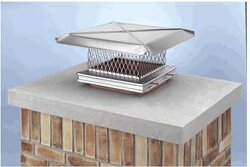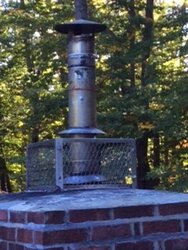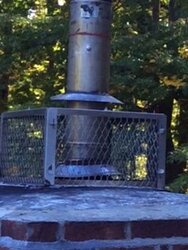We had a 2" rain storm last week and I had water dripping inside the fireplace where there is a woodstove install. I have an insulated 6" SS pipe inside a clay liner normally capped like in the photo.The day before the storm I removed the steel cap covering the top of the clay liner so that I could extend the flue a couple feet for better draft. The extension does have a cap.
One leak was from the lintel plate but no bricks above were wet. The other leak was from the back edge of the blockoff plate where it mounts to the rear of the firebox. There was NO evidence the leak was due to rain entering the clay flue liner since there were no drips along the 6" ss pipe passing thru the blockoff plate.
The only entry point I can think of was where the clay liner meets with the crown. Can that be sealed with regular silicon calk? Any ideas where else the leak can come from? There is a lot of exposed chimney crown since it's a 6' x 3' chimney with a single flue. Funny how it happened right after I removed the cap but we have been in a drought for months.
I'm stumped.
One leak was from the lintel plate but no bricks above were wet. The other leak was from the back edge of the blockoff plate where it mounts to the rear of the firebox. There was NO evidence the leak was due to rain entering the clay flue liner since there were no drips along the 6" ss pipe passing thru the blockoff plate.
The only entry point I can think of was where the clay liner meets with the crown. Can that be sealed with regular silicon calk? Any ideas where else the leak can come from? There is a lot of exposed chimney crown since it's a 6' x 3' chimney with a single flue. Funny how it happened right after I removed the cap but we have been in a drought for months.
I'm stumped.

Attachments
Last edited:




